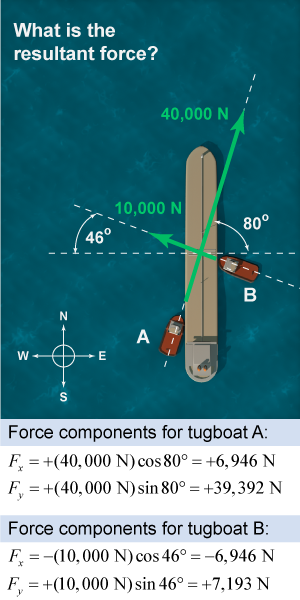|
To add two vectors, you add their x-, y-, and z-components separately. The x-component of the resultant is the sum of the x-components of each separate vector; the same is true for the y- and z-components. To subtract two vectors, you subtract the components. This is both faster and more accurate than drawing vector diagrams. Working in components is the easiest way to do calculations with vectors. 
|

|
Consider a tanker pushed by two tugboats as shown. Tugboat A pushes with a force of 40,000 N and tugboat B pushes with a force of 10,000 N. What is the net force on the tanker? Will it go straight north or will it move at an angle? The answer to both questions requires adding the two forces from the tugboats. Before this can be done, we draw the vector triangles and find the components of each force. The x- and y-axes are aligned north–south and east–west. 
| 
|
The force from tugboat A is resolved into +6,946 N in the x-direction and +39,392 N in the y-direction. Tugboat B is much less powerful, and its 10,000 N force resolves into an x-component of −6,946 N and a y-component of +7,193 N. The forces in the y-direction add to a y-component of +46,585 N. The x-components add up to zero! The net force on the tanker is Fnet = (0, 46,585) N. Since there are no forces acting in the x-direction, the tanker will go straight north. Clearly, the captain of tugboat B knew enough physics to adjust his angle to compensate for the action of the stronger tugboat A. 
|
How do you solve problems involving vectors, including force, position, speed, and others?
Follow this problem-solving strategy: - Resolve each vector into its x-, y-, and z–components.
- Add or subtract components separately for x, y, and z as needed by the problem.
- Put the components back together to arrive at the full vector solution.
Remember that subtracting a vector is the same as adding the negative of the vector. 
 |
Multiplying vectors is much trickier than adding and subtracting. There are two completely different multiplication operations. The first is the dot product and it multiplies two vectors to give a scalar. The work done by a force is the scalar dot product of the force and the displacement vectors.
The second multiplication operation is called the cross product and it produces a new vector that is perpendicular to the two vectors being multiplied. Cross products are used to represent torques—twisting forces—or forces on moving charged particles from magnetic fields. Strange as it may seem, there is no division for vectors. If A and B are vectors then A ÷ B has no meaning. 
|
| |
|

